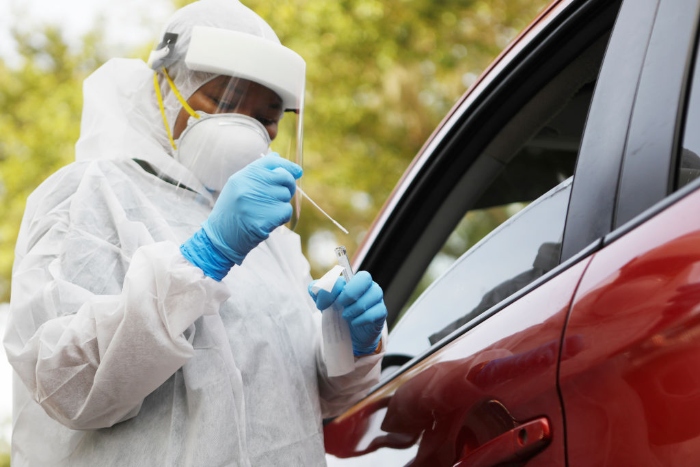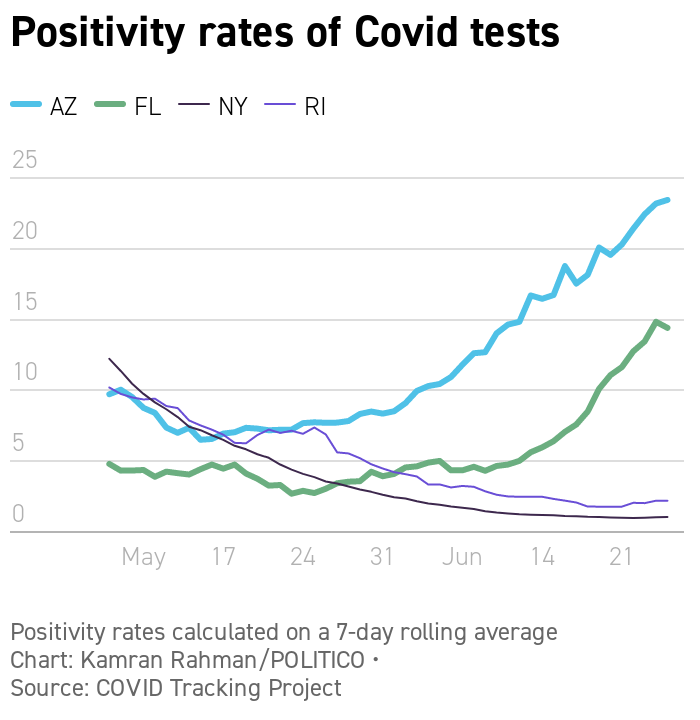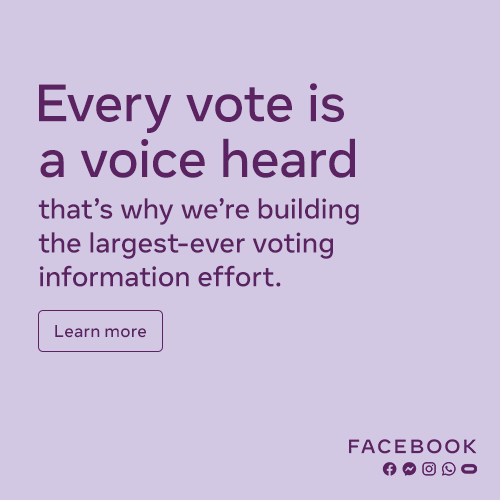
BY RYAN LIZZA AND RENUKA RAYASAM
Presented by Facebook
IT’S ALWAYS SUNNY AT THE NAVAL OBSERVATORY — When we last checked in with Vice President Mike Pence, he had just written an op-ed in The Wall Street Journal that said the news media “has tried to scare the American people” by reporting, accurately, about increases in coronavirus cases. In the June 16 article, Pence said the Trump administration’s “approach has been a success,” and that “we’ve slowed the spread.” According to the vice president, it was all “cause for celebration.”
Fast forward 10 days. This afternoon, Pence and other members of the White House Coronavirus Task Force emerged for their first public briefing since April 27, when the White House decided to send the group into hiding and emphasize economic reopening instead. Almost two months — and 70,000 more deaths — later, the Pence-led group spoke to reporters from an auditorium at the Department of Health and Human Services. In a perhaps telling sign of President Donald Trump’s priorities, the event of the day at the White House, which used to be the site of the once-daily briefings, was a meeting of Trump’s American Workforce Policy Advisory Board.
The purpose of the briefing was to update the public on the surge in coronavirus cases across the South and West. If you have read and watched Pence carefully, you could detect a modest degree of being chastened since his Wall Street Journal piece. He did not attack the news media. He made it clear that cases were rising. He advised Americans to heed the health guidelines of local officials.
But it was also clear that Pence remains locked in a mindset that downplays all bad news about the pandemic. When confronted with the growing death count, he likes to point out the daily total of dead Americans is lower than it was once. When discussing the rise in cases, he said, “Roughly half of the new cases are Americans under the age of 35, which is at a certain level very encouraging news,” because the disease is less deadly for younger people. He avoids the idea that states are experiencing spikes and prefers to discuss localized “outbreaks.”
Fair enough. There is truth to all of this. But the happy talk does not match the frightening reemergence of the virus. Perhaps most bizarrely, when asked about masks, Pence declined to recommend their use and even declined to use the word. Instead he recommended that Americans follow “statewide guidance with regards to facial coverings.” Again, this isn’t necessarily incorrect, it’s just oddly obtuse in its unwillingness to offer clear advice.
He did, however, offer one more specific piece of advice: “Continue to pray.”
Welcome to POLITICO Nightly: Coronavirus Special Edition. Attending my first Zoom wedding this weekend. Reach out with tips: rrayasam@politico.com or on Twitter at @renurayasam.
A message from Facebook:
Every vote is a voice heard. Facebook is building the largest voter information effort in US history, starting with the new Voting Information Center, where you can find the latest resources about voting in the 2020 election. Learn more about our efforts.
TUESDAY AT 1 p.m. EDT - A POLITICO TOWN HALL: AMERICA AT A TIPPING POINT: The killing of George Floyd sparked demonstrations against police brutality and racial injustice around the world. One month later, join POLITICO Live for a town hall to reflect on the past and reckon with what is next to come. Featured guests include Julián Castro, former secretary of HUD and Democratic presidential candidate; Vanita Gupta, president and chief executive of the Leadership Conference on Civil and Human Rights; Rashad Robinson, civil rights leader and president of Color of Change; and Rep. Karen Bass (D-Calif.), chair of the Congressional Black Caucus. Additional guests TBA. REGISTER HERE.
| AROUND THE NATION |
IT’S NOT JUST THE SUN BELT — Arizona, Florida and Texas are among around a dozen other states that have hit the brakes on reopening their economies as the resurgence of the virus across the South and West affects more than half of the states in the country, reporter Caitlin Oprysko writes.
California may soon follow suit, with Democratic Gov. Gavin Newsom warning this week that the state is “prepared” to issue another stay-at-home order if necessary, though adding that “We don’t intend to do that. We don’t want to do that.”
Newsom provided a glimpse today of how he might approach California’s outbreak, announcing that his administration had advised Imperial County, on the state’s southern border with Mexico, “to pull back and once again reinstitute their stay-at-home orders.” While he emphasized the county would be in control of the process the governor wouldn’t rule out intervening.
San Francisco Mayor London Breed, meanwhile, announced she was delaying the city’s next phase of reopening after infections continued to rise.
Arkansas’ Republican Gov. Asa Hutchinson announced Thursday he would not lift any further coronavirus-related restrictions the same day his state posted one of its largest single-day increases in new cases. Texas’ other neighbor to the east, Louisiana, had already announced a four-week delay before moving into its next phase of reopening.
The governors of Utah, Michigan, Kansas, Idaho, Nevada, North Carolina and Delaware have also taken similar steps to freeze the current phase of reopening.

A health care worker administers a coronavirus test to a patient at the Lee Davis Community Resource Center in Tampa, Fla. | Getty Images
| FROM THE HEALTH DESK |
CROSS PURPOSES — Texas’ new executive order restricting large public gatherings has an exemption for churches and other houses of worship. And earlier this week in Arizona, Trump held a campaign rally inside a megachurch packed with maskless supporters. These decisions, coinciding with the rising case counts in the South and West, have put a spotlight on one of the most heated debates of the pandemic: how to balance the need for religious community with the serious public health threat these spaces have repeatedly created, health care reporter Alice Miranda Ollstein emails us.
There is no First Amendment question: The Supreme Court ruled at the end of May that California, Illinois and other states could restrict religious gatherings in the name of public health. But most have been reluctant to do so even as numerous churches have become the sites of super-spreader events around the U.S. and across the globe:
Members of the Shincheonji church in South Korea led to thousands of people becoming infected. By late March, more than half the country’s total cases were tied to the outbreak.
A funeral attended by 200 people in a chapel in Albany, Ga., in February led to one of the state’s worst outbreaks and overwhelmed local hospitals.
A religious rally at a church in early March on the Navajo reservation in Arizona fueled an especially deadly outbreak.
An outbreak at a rural Arkansas church in March left dozens infected and four dead.
One person who attended a church choir practice in Washington state infected 87 percent of the group, two of whom died. “Transmission was likely facilitated by close proximity (within 6 feet) during practice and augmented by the act of singing,” a CDC investigation concluded.
A church in Oregon that held services throughout April and May in defiance of the state’s restrictions on large gatherings was found earlier this month to be the epicenter of the state’s largest outbreak, with more than 200 people infected.
While some religious leaders have supported the suspension of in-person services during the pandemic — and found creative workarounds like squirt gun baptisms, Zoom minyans and drive-through confessions — others have opposed it vehemently.
The CDC initially released suggestions for worshipers to stay safe, such as holding multiple smaller services to allow people to maintain distance, holding services outdoors, and altering high-touch activities like passing a collection plate. The agency quietly modified the guidelines in late May, however, deleting a recommendation that churches “consider suspending or at least decreasing use of a choir/musical ensembles and congregant singing, chanting, or reciting.”
Home openers — Nearly a dozen states, mainly in places without large Covid-19 infection spikes, are beginning to allow nursing home residents to see family and friends — as long as they do it outside, health care reporter Rachel Roubein emails us.
The guidance from states is generally strict, requiring masks and mandating social distancing. In Illinois and New Jersey, only two visitors are allowed per resident. In Maryland, outdoor visitation is permitted only if the facility doesn’t have a Covid-19 outbreak. And Minnesota’s guidance expressly notes that hugging, holding hands and kissing is prohibited.
But in Oklahoma, a state where hospitalizations are on the rise, the governor’s guidelines say that outside visits are preferred but not required.
The Centers for Medicare and Medicaid Services urged restrictions on nursing home visitors in mid-March. CMS gave the greenlight this week to let homes be creative in allowing residents to see visitors outside, such as on courtyards, patios and in parking lots.
| FROM THE STATES DESK |

EMPIRE STATE STRIKES BACK — The number of people being hospitalized with Covid in New York dropped below 1,000 Thursday for the first time since March. While the state’s 31,000 deaths account for a quarter of the country’s total, the rate of positive tests to overall tests is now at 1.1 percent — a sign that the virus is on the decline. As states in the South and West shut down businesses, New York is forging ahead with its reopening plans. Indoor dining and outdoor sports will resume in New York City. The state, whose residents were once unwelcome in Florida and Rhode Island, is now asking travelers from half a dozen hotspot states to quarantine. (Connecticut and New Jersey are doing the same.) Your host chatted with POLITICO New York Playbook author Anna Gronewold over Slack today about how fear is a motivator, how the tables have turned and whether New York’s Democratic Gov. Andrew Cuomo should be taking a victory lap. This conversation has been edited.
Does this feel like relief?
It does. It's been hard to explain to friends, family and colleagues elsewhere the sheer sense of terror in New York for a few months. Everyone knew someone who was sick, and for better or worse, we were getting updates every day from Gov. Cuomo, making it hard to forget about or ignore. I went into a store the other day and was surprised how wary I felt, how after just 3 to 4 months our entire psyche has changed.
Is Cuomo running a victory lap?
You said it, not me!
Ha!
There’s definitely a sense of “I told you so.” Shutting down New York City entirely was a massive decision and reopening it so slowly has earned some criticism. Right now the numbers justify Cuomo’s approach, and that’s got to feel good for the administration. Or as good as you can feel with such a devastating set of circumstances.
But as folks in Texas keep reminding me: New York still has a huge death rate, by far the largest in the nation. So is all the smugness warranted?
We can, and have, and will debate the perfect storm that made New York such a terrifying place when the virus first hit the U.S. Was it poor collaboration between the city and the state? Was it misinformation spread by New York leaders? Was it bad federal information they shouldn’t have trusted in the first place? Was it New York City’s unparalleled density and huge health disparities? Was it simply the fact that no one had practical experience dealing with this so everything was trial and error?
I think the answer to all is “probably.” And I do think, whether the administration says it or not, there are many decisions that leaders would have made differently if they were able to go back.
Anything that governors — and residents — in TX, FL and AZ can learn about the NY experience? Should we be scared? Should leaders be more aggressive?
Oh boy, that is a political, psychological and public health question I am not qualified to answer. But I think fear has kept folks’ masks on, hand sanitizer in their pockets and accepting of canceling big gatherings like sports, concerts and marathons. I've talked to nurses who couldn’t keep track of the bodies they were wheeling out of the hospitals and people who were ill who described how their lungs felt like shards of glass each time they tried to breathe. That’s how a lot of people in New York see coronavirus and it’s a motivation. So without that fear, I can see how easy it would be to feel immune.
| ASK THE AUDIENCE |
Nightly asked you: If you were going to erect a statue in the place where you live, who or what would you choose? And why? Here are some of your lightly edited responses.
“In my neighborhood, I would love to see a statue erected to Emily Roebling, an engineer who was instrumental in getting the Brooklyn Bridge built after her husband, Washington Roebling, was stricken with caisson disease. The first person to cross the bridge when it opened in 1883, she held a live rooster on her lap, symbolizing victory.” — Nicholas Teddy, digital marketing, Brooklyn, N.Y.
“Without a doubt, we need a national monument to America’s greatest songwriter and Nobel laureate Bob Dylan. His love songs hit like a corkscrew to the heart, and his new album is a triumph. Let’s honor him now.” — Brent Ewig, writer and public health consultant, Silver Spring, Md.
“Rachel Carson, the woman who dedicated her life to a years-long battle to ban the widespread use of the pesticide DDT, and author of the book Silent Spring, which served to open the public’s eyes to its terrible dangers.”
— MORGAN DEVINE, SMALL BUSINESS OWNER, ANAHEIM, CALIF.
|
“Mr. Rogers. ’Nuff said.” — Judith Kenigson, interpreter and translator, Nashville
“Anthony Fauci. He is one of few public officials we can currently trust. He was a hero with HIV, and he is a hero again with Covid. He will be a hero a hundred years from now.” — Lasse Van Essen, retired, Washington, D.C.
“In this era of easily offended people, I wouldn’t put up a statue at all. I’d just plant flowers.” — Ann E. Posakony, Ventura, Calif.
FOR CRITICAL NEWS AND CONTEXT YOU NEED IN 15 MINUTES OR LESS, LISTEN TO POLITICO DISPATCH: Coronavirus cases continue to spike as states take steps to reopen. Americans are demanding action from lawmakers to address racial injustice and police reform. How do you keep up with the never-ending news cycle? For quick analysis on the essential news of the day, listen to POLITICO Dispatch, our short daily podcast that keeps you up to date on the most important news affecting your life. Subscribe and listen today.
| PALACE INTRIGUE |
50 WAYS TO LEAVE A LOCKDOWN — Though cases are rising across the country, the White House has remained hands-off, attributing the surge to an increase in testing. Health care reporter Adam Cancryn explains how that’s left state officials overwhelmed — and why those claims about testing are misleading — in the latest edition of POLITICO Dispatch.
| NIGHTLY NUMBER |
$27.9 billion
The amount of money still needed for a World Health Organization initiative to ramp up development and production of new coronavirus diagnostics, therapeutics and vaccines, according to a WHO statement today . The initiative needs $31.3 billion, but to date it has only received $3.4 billion. (h/t Europe health care reporter Ashleigh Furlong)
|
| PARTING WORDS |
SPRECHEN SIE DEUTSCH? English may be the European Union’s lingua franca, but listen carefully in the corridors of power and you’ll find the language of Goethe and Schiller is on the rise. German is gaining ground among the EU’s three official working languages, Joshua Posaner writes, as Berlin prepares to take on the bloc’s presidency next month. That’s not least because native speakers occupy top positions
The Goethe Institute, Germany’s state-funded cultural outpost, told Josh it saw a five-fold increase in demand for its free language tuition service for diplomats and journalists in Brussels between 2012 and 2019. That’s part of Europanetzwerk Deutsch, a state-funded, soft power initiative to lift those with some knowledge of German into working proficiency.
Worldwide, some 15.4 million people are now learning the language, according to a five-year review published this month by the German government. Compared with the last survey in 2015, there has been a 62 percent rise in Denmark, 16 percent in France and 30 percent in the Netherlands. With 2 million Poles now practicing their der, die and das, any lingering historical sensitivity around promoting German as an international language has been replaced by the gravitational pull of Europe’s largest economy, helped by the country’s modern image as a bulwark of liberal values.
A message from Facebook:
How Facebook is preparing for the US 2020 election
— Tripled safety and security teams to 35,000 people
— Implemented 5-step political ad verification
— Providing greater political ad transparency
— Launching new Voting Information Center
Learn about these efforts and more.
— Tripled safety and security teams to 35,000 people
— Implemented 5-step political ad verification
— Providing greater political ad transparency
— Launching new Voting Information Center
Learn about these efforts and more.
Did someone forward this email to you? Sign up here.
Follow us on Twitter
Renuka Rayasam @renurayasam
|
FOLLOW US
|



No comments:
Post a Comment
Note: Only a member of this blog may post a comment.